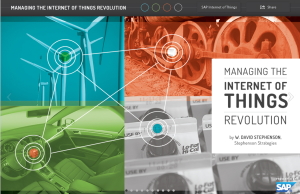After a harrowing trip via Air France (#neveragain) I’m in lovely Barcelona, live-blogging Gartner ITxpo courtesy of Siemens — but they aren’t dictating my editorial judgment.
Keynoter is Peter Sondergaard, Sr. VP, Gartner Research:
- start with high-scale traditional IT structures, but with new emphasis on cloud, etc. IT system now partially inside your org. and part outside. We are half-way through transition to cloud: half of sales support now through cloud. More financial, HR & other functions. General trend toward cloud, but still some internal processes as necessary. Must clean up traditional inside processes.
- “Ecosystems are the next evolution of Digital”
- Must learn to measure your investments in customer experience.
- Starting to explore VR & AR (personal shout out to PTC & clients such as Caterpillar!!)
- must understand customer’s intent through advanced algorithms. Create solutions to problems they don’t even know they have!
- next domain of new platform: Things:
- build strategies with two lenses: consumer preferences, AND the enterprise IoT lens.
- leverage exponential growth in connected things
- 27445 exabytes of data by 2020!
- can’t just bolt on new systems on old ones: must rework existing systems to include devices — processes, workflow, much harder (i.e., my circular company paradigm).
- intelligence: how your systems learn and decide independently
- algorithms– algorithmic intelligence — drives decisions
- now, AI, driven by machine learning. Machines learn from experience.
- information is new code base
- we will employ people to train things to learn from experience through neural networks
- ecosystems
- linear value supply chains transformed to ecosystems through electronic interchange.
- others can build experiences, etc. that you haven’t thought out through APIs — my “share data” Essential Truth. APIs implement business policies in the digital world.c
- customers
- customer driven
Where to start?
- 70% of IoT implementation is through new organization within companies!
Now other Gartner analysts chime in:
- insurance: engage your customers.
- smart gov: must interact with those who implement. Must re-imaging public involvement sense/engage/interact
- case study: Deakin University in Australia: digital platforms to enhance student experience.
- case study: Trenitalia mass transit system switching to predictive maintenance! Huge cost savings. “Experience hands & beginners mind at work” — love that slogan!!!! “Listen to the train instead of scheduling maintenance”
- blockchain: ecosystem, brilliant in simplicity. All can see transaction but no one can invade privacy. Use to solve many problems: data provenance, land registry, public infrastucture, AI.
- Woo: use this to TRANSFORM THE WORLD!!!
- ratz — I was preoccupied at time, they talked about a new mobility system for seniors — re my SmartAging paradigm!!
- paradigm shift — partnering with competitors (much of what I wrote about in DataDynamite: share data, don’t hoard it!) Think about Apple & Google driving car companies’ interfaces. “Do you join hands with digital giants or join hands with them?”).
- ooh, love the digital assistant correcting his presentation. I can only dream of a future where there are millions added to grammar police!

